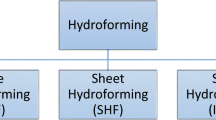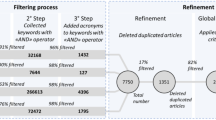Abstract
Main advantages of cold forging are improvement of mechanical properties, excellent dimensional accuracy, and surface quality. Hot forging is a processing of plastic deformation for the metal at recrystallization temperature or higher. It is possible to decrease the flow stress and energy required to form the material at elevated temperature. Complex forging for combining cold forging and hot forging was applied in this study to ensure the shape accuracy of engine mounting parts. The complex forging technology of engine mounting parts would be very useful to improve dimension accuracy, reduce manufacturing cost, and increase die life.
Similar content being viewed by others
References
Han, M. S. and Cho, J. U., “Structural Analysis of Engine Mounting Bracket,” Journal of the Korean Society of Manufacturing Technology Engineers, Vol. 21, No. 4, pp. 525–531, 2012.
Park, U.-H. and Song, Y.-C., “The Optimization of Vehicle Engine Mounting System Using DFSS (Design for Six Sigma) Technique,” The Korean Society of Noise and Vibration Engineering, Vol. 20, No. 3, pp. 235–241, 2010.
Park, S. S., Kim, B. M., and Lee, J. M., “Process Design of Cold Forging for Drum Clutch with Inner Tooth Component,” J. Korean Soc. Precis. Eng., Vol. 22, No. 2, pp. 30–37, 2005.
Lee, K.-O., Kim, J.-M., Je, J.-S., and Kang, S.-S., “Development of Precise Clutch Gear for Automobile Transmission by Compound Forging Process,” J. Korean Soc. Precis. Eng., Vol. 23, No. 1, pp. 185–192, 2006.
Lee, H. S., Kim, T. H., Kim, S. H., Hong, E. C., and Lee, J. H., “A Study on the Optimum Design for Energy Saving of an Auto Transmission Part,” Transactions of Materials Processing, Vol. 24, No. 3, pp. 181–186, 2015.
Kwon, H.-H., Moon, K.-J., and Song, S.-E., “Forging Process Analysis of the Multi-Forging Die for the Unified Universal Pipe Joint of the Intermediate Shaft,” Journal of the Korean Society of Manufacturing Technology Engineers, Vol. 19, No. 1, pp. 33–41, 2010.
Song, S.-E. and Kwon, H.-H., “A Study on the Cold Forging Development of Guide Valve for the Fuel Pressure Regulator,” Journal of the Korean Society of Manufacturing Technology Engineers, Vol. 21, No. 2, pp. 331–336, 2012.
Kang, B. S. and Ku, T. W., “Process Modification and Numerical Simulation for an Outer Race of a CV Joint Using Multi-Stage Cold Forging,” Transactions of Materials Processing, Vol. 23, No. 4, pp. 211–220, 2014.
Jeon, H. W., Yoon, J. H., Lee, J. H., and Kim, B. M., “Plate Forging Process Design for an Under-Drive Brake Piston in Automatic Transmission,” Transactions of Materials Processing, Vol. 23, No. 2, pp. 88–94, 2014.
Author information
Authors and Affiliations
Corresponding author
Rights and permissions
About this article
Cite this article
Park, DH., Kwon, HH. Development of automobile engine mounting parts using hot-cold complex forging technology. Int. J. of Precis. Eng. and Manuf.-Green Tech. 3, 179–184 (2016). https://doi.org/10.1007/s40684-016-0023-5
Received:
Revised:
Accepted:
Published:
Issue Date:
DOI: https://doi.org/10.1007/s40684-016-0023-5




